


Christmas Store
The holidays are just around the corner so now is the time to fetch the finest gifts for the Labrador Lover on your Christmas list. We have over 100 gifts $50.00 and under. Visit our Christmas Store.
For the Lab
Bedding
Coats
Collars and Leads
Dog Bowls
Feeding Stations
Spa and Grooming
Toys and Treats
Travel and Accessories
For the Lab Lover
Apparel
Cards and Giftwrap
Fine Accessories
Gifts and All Occasions
Jewelry
Kids Only
For the Lab Home
Artwork
Books
Garden and Outdoor
Home Furnishings
Kitchen Accessories
Pillows, Throws, and Rugs
Gift ServicesGift Boxes
Gift Certificates
Meet Finny: A Conservative Lab
By Regan Michelle White
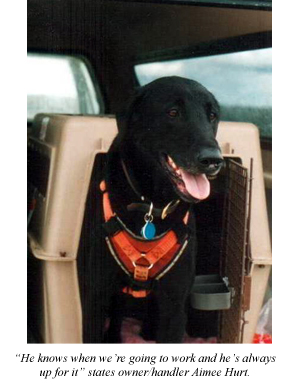 Increasing concern about the status of rare species and endangered wildlife populations, coupled with the difficulties inherent to finding them, has prompted the development and increased the growth of non-invasive methods for wildlife monitoring and research. Fin, a 9-year-old black Lab, is a veteran of these cutting edge conservation methods.
Increasing concern about the status of rare species and endangered wildlife populations, coupled with the difficulties inherent to finding them, has prompted the development and increased the growth of non-invasive methods for wildlife monitoring and research. Fin, a 9-year-old black Lab, is a veteran of these cutting edge conservation methods.
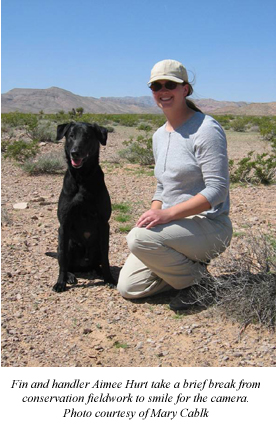 Fin and handler Aimee Hurt of Working Dogs for Conservation (WDC) based out of Montana, work to sample wildlife populations through the detection of these animals and more often, their scat. Founded in 2000, WDC is a partnership between Hurt and three other biologist and wildlife professional friends who are committed to developing and furthering the training and use of canine-human teams for non-invasive scientific inquiry. “We wanted to promote the use of dogs (for non-invasive conservation work) both to find wildlife and wildlife scat,” Hurt said. In addition to being able to supply their own four veteran dogs, Hurt and her team also train other dogs and develop research projects and dog training projects for clients. Typically Hurt and her team are hired on a contractor basis. As of this year WDC has their own non-profit foundation which will hopefully pave the way to a number of federal grants that will enable Hurt, Fin and company to take on all aspects of conservation research.
Fin and handler Aimee Hurt of Working Dogs for Conservation (WDC) based out of Montana, work to sample wildlife populations through the detection of these animals and more often, their scat. Founded in 2000, WDC is a partnership between Hurt and three other biologist and wildlife professional friends who are committed to developing and furthering the training and use of canine-human teams for non-invasive scientific inquiry. “We wanted to promote the use of dogs (for non-invasive conservation work) both to find wildlife and wildlife scat,” Hurt said. In addition to being able to supply their own four veteran dogs, Hurt and her team also train other dogs and develop research projects and dog training projects for clients. Typically Hurt and her team are hired on a contractor basis. As of this year WDC has their own non-profit foundation which will hopefully pave the way to a number of federal grants that will enable Hurt, Fin and company to take on all aspects of conservation research.
WDC dogs are selected for their ability and willingness to work and maintain focus when subjected to all variations of distractions and temptations such as flushed wildlife, roadway traffic, human observers, baited hair snag and trapping stations and domestic animals. Fin found his way to Aimee seven years ago. He was donated by a family to a narcotics training program which he failed out of due to his over exuberance in indoor searches. Outdoor searches however turned out to be a whole different ball game – a game in which Fin excelled.
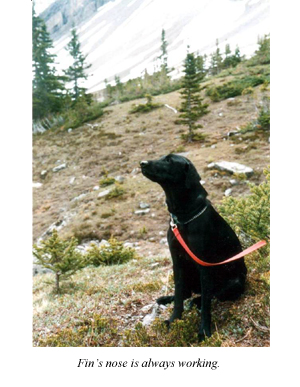 Fin and the other WDC dogs are trained using modified narcotic, forensic, and search and rescue techniques. “From a training perspective I’ve only really formally grown up in this discipline (of scientific research dog training). However, I had some narcotics training as a base and really just look to all different disciplines and creatively piece things together as we go along for what we need,” Hurt said. Two of her most helpful training guides have interestingly been “K9 Suspect Discrimination Training and Practicing” by Schoon and Haak and “The Cadaver Dog Handbook” by Rebmann, Koenig, David and Sorg.
Fin and the other WDC dogs are trained using modified narcotic, forensic, and search and rescue techniques. “From a training perspective I’ve only really formally grown up in this discipline (of scientific research dog training). However, I had some narcotics training as a base and really just look to all different disciplines and creatively piece things together as we go along for what we need,” Hurt said. Two of her most helpful training guides have interestingly been “K9 Suspect Discrimination Training and Practicing” by Schoon and Haak and “The Cadaver Dog Handbook” by Rebmann, Koenig, David and Sorg.
Training of WDC dogs begins with scent introduction in enclosed scent boxes and proceeds to double blind field simulations in which both dog and handler are unapprised of scent target locations. Fin and the other WDC dogs are trained to alert on target odors and indicate a find by performing a trained alert and avoiding any direct contact with the target itself. Fin is trained to detect the scat of Black bear, Grizzly bear, mountain lion, wolf, kit fox and lynx. “Primarily the scat he’s trained for tend to be limited and dependent on the species that are of environmental concern,” Hurt said. He is also trained to find live desert tortoises and black-footed ferrets.
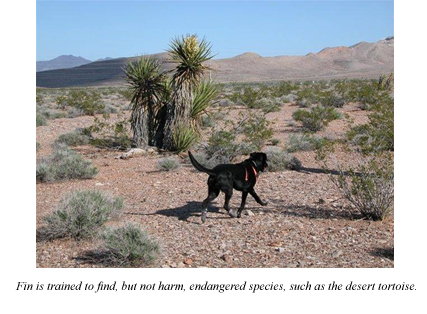 Interestingly, the process of training for live wildlife finds versus scat finds is not that different. “With scat it is relatively easy to get an actual scent that the dog is scenting for because you can use a sample of the scat itself from the field. As far as live endangered animals go, we don’t have corrals of the live animal itself obviously, so we have to train off of bedding that has animal scent and other such samples,” Hurt explained. With scientific advances in the past decade, scat samples have been able to yield almost as much, if not more, information as recovery of the endangered animal itself. Scat samples can provide information such as species’ presence, relative abundance, food habits, parasite loads, habitat use and home range size. Analyses of endocrine extracted from scats can determine the sex and reproductive status of individuals and analyses of the DNA contained in scat can verify species and sex, and potentially determine population size, home range, paternity and kinship. “Almost anything that you can determine from a tissue or blood sample you could probably get from scat,” Hurt said
Interestingly, the process of training for live wildlife finds versus scat finds is not that different. “With scat it is relatively easy to get an actual scent that the dog is scenting for because you can use a sample of the scat itself from the field. As far as live endangered animals go, we don’t have corrals of the live animal itself obviously, so we have to train off of bedding that has animal scent and other such samples,” Hurt explained. With scientific advances in the past decade, scat samples have been able to yield almost as much, if not more, information as recovery of the endangered animal itself. Scat samples can provide information such as species’ presence, relative abundance, food habits, parasite loads, habitat use and home range size. Analyses of endocrine extracted from scats can determine the sex and reproductive status of individuals and analyses of the DNA contained in scat can verify species and sex, and potentially determine population size, home range, paternity and kinship. “Almost anything that you can determine from a tissue or blood sample you could probably get from scat,” Hurt said
Fin’s prowess at detecting and discriminating between scents is apparent. He can distinguish between kit and coyote. He is able to learn a scent and recognize a scat sample within a day. The challenge lies in determining that he is accurately scenting for only a specific species and not associating the scent with something like it. More time consuming still is the fact that Hurt and her partners simulate the environmental working conditions that the dogs will be in while scenting. “The scat and scent training is relatively quick getting him acclimated to a realistic training setting that we replicate as authentically as we can takes a bit longer,” Hurt said. In total the entire process takes a month on average. The replication of realistic training settings has proven important for both WDC dogs and their handlers, as their conservation efforts have brought them to many points in North America.
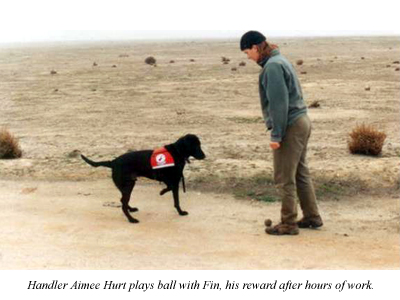 This line of work seems the perfect fit for a guy like Fin. “He’s a great problem solver, all you have to do is just stand back and get out of his way,” Hurt said. “His personality is absolutely unflappable – it’s probably the Lab in him. He takes what he knows and he applies it to the current need.” In terms of challenges, time and experience seem to have swiped any away. “It’s great he’s to the point in his career where he’s a veteran. When he was young he’d sometimes go too fast and then have to double back. He learned he had to slow down and pay closer attention. He’s a pro,” Hurt said. “He was diagnosed with cancer last year and had to have his penis removed and that’s been our only challenge together … mainly for me, really. He’s just unflappable, thrilled and happy to be out and about.”
This line of work seems the perfect fit for a guy like Fin. “He’s a great problem solver, all you have to do is just stand back and get out of his way,” Hurt said. “His personality is absolutely unflappable – it’s probably the Lab in him. He takes what he knows and he applies it to the current need.” In terms of challenges, time and experience seem to have swiped any away. “It’s great he’s to the point in his career where he’s a veteran. When he was young he’d sometimes go too fast and then have to double back. He learned he had to slow down and pay closer attention. He’s a pro,” Hurt said. “He was diagnosed with cancer last year and had to have his penis removed and that’s been our only challenge together … mainly for me, really. He’s just unflappable, thrilled and happy to be out and about.”
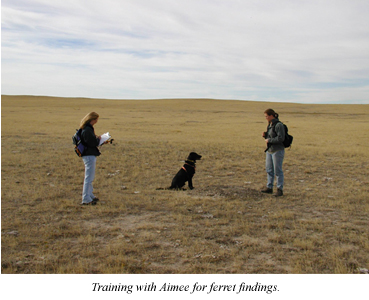 Fin is currently consumed with training for live black-footed ferret searches for the Colorado Division of Wildlife and Bureau of Land Management and in late summer he will be looking for black bear, grizzly bear, wolf and mountain lion scat for the Wildlife Conservation Society’s Centennial Carnivore Connectivity project. When not hard at work, Fin takes it easy at home in Missoula lolling around with an 11-year-old Norwegian elkhound whose only job is to be a good lap dog, and a new dog that Aimee is training, a black Lab mix from a local shelter named Wicket. “We now call Fin ‘Uncle Finny’ since we got the new dog (Wicket) and I’m sure he’s teaching her all sorts of bad habits,” Hurt said with a laugh. When not managing wildlife, or mischief, Fin just prefers to watch the world go by from his spot on the couch and dig up dandelions-understandably relaxing pastimes for a Lab of the Month who always has such important work on his paws.
Fin is currently consumed with training for live black-footed ferret searches for the Colorado Division of Wildlife and Bureau of Land Management and in late summer he will be looking for black bear, grizzly bear, wolf and mountain lion scat for the Wildlife Conservation Society’s Centennial Carnivore Connectivity project. When not hard at work, Fin takes it easy at home in Missoula lolling around with an 11-year-old Norwegian elkhound whose only job is to be a good lap dog, and a new dog that Aimee is training, a black Lab mix from a local shelter named Wicket. “We now call Fin ‘Uncle Finny’ since we got the new dog (Wicket) and I’m sure he’s teaching her all sorts of bad habits,” Hurt said with a laugh. When not managing wildlife, or mischief, Fin just prefers to watch the world go by from his spot on the couch and dig up dandelions-understandably relaxing pastimes for a Lab of the Month who always has such important work on his paws.
For more information visit www.workingdogsforconservation.org.
Click here to go back to Lab of the Month
By Regan Michelle White
 Increasing concern about the status of rare species and endangered wildlife populations, coupled with the difficulties inherent to finding them, has prompted the development and increased the growth of non-invasive methods for wildlife monitoring and research. Fin, a 9-year-old black Lab, is a veteran of these cutting edge conservation methods.
Increasing concern about the status of rare species and endangered wildlife populations, coupled with the difficulties inherent to finding them, has prompted the development and increased the growth of non-invasive methods for wildlife monitoring and research. Fin, a 9-year-old black Lab, is a veteran of these cutting edge conservation methods.  Fin and handler Aimee Hurt of Working Dogs for Conservation (WDC) based out of Montana, work to sample wildlife populations through the detection of these animals and more often, their scat. Founded in 2000, WDC is a partnership between Hurt and three other biologist and wildlife professional friends who are committed to developing and furthering the training and use of canine-human teams for non-invasive scientific inquiry. “We wanted to promote the use of dogs (for non-invasive conservation work) both to find wildlife and wildlife scat,” Hurt said. In addition to being able to supply their own four veteran dogs, Hurt and her team also train other dogs and develop research projects and dog training projects for clients. Typically Hurt and her team are hired on a contractor basis. As of this year WDC has their own non-profit foundation which will hopefully pave the way to a number of federal grants that will enable Hurt, Fin and company to take on all aspects of conservation research.
Fin and handler Aimee Hurt of Working Dogs for Conservation (WDC) based out of Montana, work to sample wildlife populations through the detection of these animals and more often, their scat. Founded in 2000, WDC is a partnership between Hurt and three other biologist and wildlife professional friends who are committed to developing and furthering the training and use of canine-human teams for non-invasive scientific inquiry. “We wanted to promote the use of dogs (for non-invasive conservation work) both to find wildlife and wildlife scat,” Hurt said. In addition to being able to supply their own four veteran dogs, Hurt and her team also train other dogs and develop research projects and dog training projects for clients. Typically Hurt and her team are hired on a contractor basis. As of this year WDC has their own non-profit foundation which will hopefully pave the way to a number of federal grants that will enable Hurt, Fin and company to take on all aspects of conservation research.WDC dogs are selected for their ability and willingness to work and maintain focus when subjected to all variations of distractions and temptations such as flushed wildlife, roadway traffic, human observers, baited hair snag and trapping stations and domestic animals. Fin found his way to Aimee seven years ago. He was donated by a family to a narcotics training program which he failed out of due to his over exuberance in indoor searches. Outdoor searches however turned out to be a whole different ball game – a game in which Fin excelled.
 Fin and the other WDC dogs are trained using modified narcotic, forensic, and search and rescue techniques. “From a training perspective I’ve only really formally grown up in this discipline (of scientific research dog training). However, I had some narcotics training as a base and really just look to all different disciplines and creatively piece things together as we go along for what we need,” Hurt said. Two of her most helpful training guides have interestingly been “K9 Suspect Discrimination Training and Practicing” by Schoon and Haak and “The Cadaver Dog Handbook” by Rebmann, Koenig, David and Sorg.
Fin and the other WDC dogs are trained using modified narcotic, forensic, and search and rescue techniques. “From a training perspective I’ve only really formally grown up in this discipline (of scientific research dog training). However, I had some narcotics training as a base and really just look to all different disciplines and creatively piece things together as we go along for what we need,” Hurt said. Two of her most helpful training guides have interestingly been “K9 Suspect Discrimination Training and Practicing” by Schoon and Haak and “The Cadaver Dog Handbook” by Rebmann, Koenig, David and Sorg.Training of WDC dogs begins with scent introduction in enclosed scent boxes and proceeds to double blind field simulations in which both dog and handler are unapprised of scent target locations. Fin and the other WDC dogs are trained to alert on target odors and indicate a find by performing a trained alert and avoiding any direct contact with the target itself. Fin is trained to detect the scat of Black bear, Grizzly bear, mountain lion, wolf, kit fox and lynx. “Primarily the scat he’s trained for tend to be limited and dependent on the species that are of environmental concern,” Hurt said. He is also trained to find live desert tortoises and black-footed ferrets.
 Interestingly, the process of training for live wildlife finds versus scat finds is not that different. “With scat it is relatively easy to get an actual scent that the dog is scenting for because you can use a sample of the scat itself from the field. As far as live endangered animals go, we don’t have corrals of the live animal itself obviously, so we have to train off of bedding that has animal scent and other such samples,” Hurt explained. With scientific advances in the past decade, scat samples have been able to yield almost as much, if not more, information as recovery of the endangered animal itself. Scat samples can provide information such as species’ presence, relative abundance, food habits, parasite loads, habitat use and home range size. Analyses of endocrine extracted from scats can determine the sex and reproductive status of individuals and analyses of the DNA contained in scat can verify species and sex, and potentially determine population size, home range, paternity and kinship. “Almost anything that you can determine from a tissue or blood sample you could probably get from scat,” Hurt said
Interestingly, the process of training for live wildlife finds versus scat finds is not that different. “With scat it is relatively easy to get an actual scent that the dog is scenting for because you can use a sample of the scat itself from the field. As far as live endangered animals go, we don’t have corrals of the live animal itself obviously, so we have to train off of bedding that has animal scent and other such samples,” Hurt explained. With scientific advances in the past decade, scat samples have been able to yield almost as much, if not more, information as recovery of the endangered animal itself. Scat samples can provide information such as species’ presence, relative abundance, food habits, parasite loads, habitat use and home range size. Analyses of endocrine extracted from scats can determine the sex and reproductive status of individuals and analyses of the DNA contained in scat can verify species and sex, and potentially determine population size, home range, paternity and kinship. “Almost anything that you can determine from a tissue or blood sample you could probably get from scat,” Hurt saidFin’s prowess at detecting and discriminating between scents is apparent. He can distinguish between kit and coyote. He is able to learn a scent and recognize a scat sample within a day. The challenge lies in determining that he is accurately scenting for only a specific species and not associating the scent with something like it. More time consuming still is the fact that Hurt and her partners simulate the environmental working conditions that the dogs will be in while scenting. “The scat and scent training is relatively quick getting him acclimated to a realistic training setting that we replicate as authentically as we can takes a bit longer,” Hurt said. In total the entire process takes a month on average. The replication of realistic training settings has proven important for both WDC dogs and their handlers, as their conservation efforts have brought them to many points in North America.
 This line of work seems the perfect fit for a guy like Fin. “He’s a great problem solver, all you have to do is just stand back and get out of his way,” Hurt said. “His personality is absolutely unflappable – it’s probably the Lab in him. He takes what he knows and he applies it to the current need.” In terms of challenges, time and experience seem to have swiped any away. “It’s great he’s to the point in his career where he’s a veteran. When he was young he’d sometimes go too fast and then have to double back. He learned he had to slow down and pay closer attention. He’s a pro,” Hurt said. “He was diagnosed with cancer last year and had to have his penis removed and that’s been our only challenge together … mainly for me, really. He’s just unflappable, thrilled and happy to be out and about.”
This line of work seems the perfect fit for a guy like Fin. “He’s a great problem solver, all you have to do is just stand back and get out of his way,” Hurt said. “His personality is absolutely unflappable – it’s probably the Lab in him. He takes what he knows and he applies it to the current need.” In terms of challenges, time and experience seem to have swiped any away. “It’s great he’s to the point in his career where he’s a veteran. When he was young he’d sometimes go too fast and then have to double back. He learned he had to slow down and pay closer attention. He’s a pro,” Hurt said. “He was diagnosed with cancer last year and had to have his penis removed and that’s been our only challenge together … mainly for me, really. He’s just unflappable, thrilled and happy to be out and about.”  Fin is currently consumed with training for live black-footed ferret searches for the Colorado Division of Wildlife and Bureau of Land Management and in late summer he will be looking for black bear, grizzly bear, wolf and mountain lion scat for the Wildlife Conservation Society’s Centennial Carnivore Connectivity project. When not hard at work, Fin takes it easy at home in Missoula lolling around with an 11-year-old Norwegian elkhound whose only job is to be a good lap dog, and a new dog that Aimee is training, a black Lab mix from a local shelter named Wicket. “We now call Fin ‘Uncle Finny’ since we got the new dog (Wicket) and I’m sure he’s teaching her all sorts of bad habits,” Hurt said with a laugh. When not managing wildlife, or mischief, Fin just prefers to watch the world go by from his spot on the couch and dig up dandelions-understandably relaxing pastimes for a Lab of the Month who always has such important work on his paws.
Fin is currently consumed with training for live black-footed ferret searches for the Colorado Division of Wildlife and Bureau of Land Management and in late summer he will be looking for black bear, grizzly bear, wolf and mountain lion scat for the Wildlife Conservation Society’s Centennial Carnivore Connectivity project. When not hard at work, Fin takes it easy at home in Missoula lolling around with an 11-year-old Norwegian elkhound whose only job is to be a good lap dog, and a new dog that Aimee is training, a black Lab mix from a local shelter named Wicket. “We now call Fin ‘Uncle Finny’ since we got the new dog (Wicket) and I’m sure he’s teaching her all sorts of bad habits,” Hurt said with a laugh. When not managing wildlife, or mischief, Fin just prefers to watch the world go by from his spot on the couch and dig up dandelions-understandably relaxing pastimes for a Lab of the Month who always has such important work on his paws. For more information visit www.workingdogsforconservation.org.
Click here to go back to Lab of the Month
Featured Article
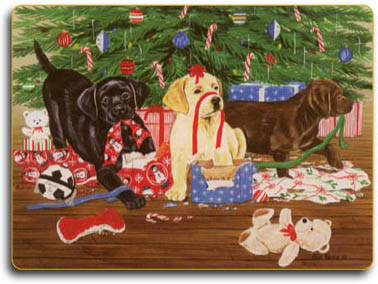 Can You Spot The Holiday Hazards?
Can You Spot The Holiday Hazards?
It’s easy for pets, especially Labradors, to get into trouble during the holidays. You may get so busy that you lose track of what is going on with your dog.
Click here to learn more about: "Can You Spot The Holiday Hazards?"
 Can You Spot The Holiday Hazards?
Can You Spot The Holiday Hazards?It’s easy for pets, especially Labradors, to get into trouble during the holidays. You may get so busy that you lose track of what is going on with your dog.
Click here to learn more about: "Can You Spot The Holiday Hazards?"
Wanted: Models

Would you like to see your Lab pictured here? Send us images of your Lab and we may include them on our Home Page!

Would you like to see your Lab pictured here? Send us images of your Lab and we may include them on our Home Page!
Labrador Library
Labrador Links
The Verstaile Lab
History of the Lab
Advice
Travel
Featured Labs
Featured Artists
Labrador Links
The Verstaile Lab
History of the Lab
Advice
Travel
Featured Labs
Featured Artists
.jpg)

